Learn how to make Kombu Dashi, a vegan-friendly Japanese soup stock, at home and enhance your Japanese dishes with umami flavor!
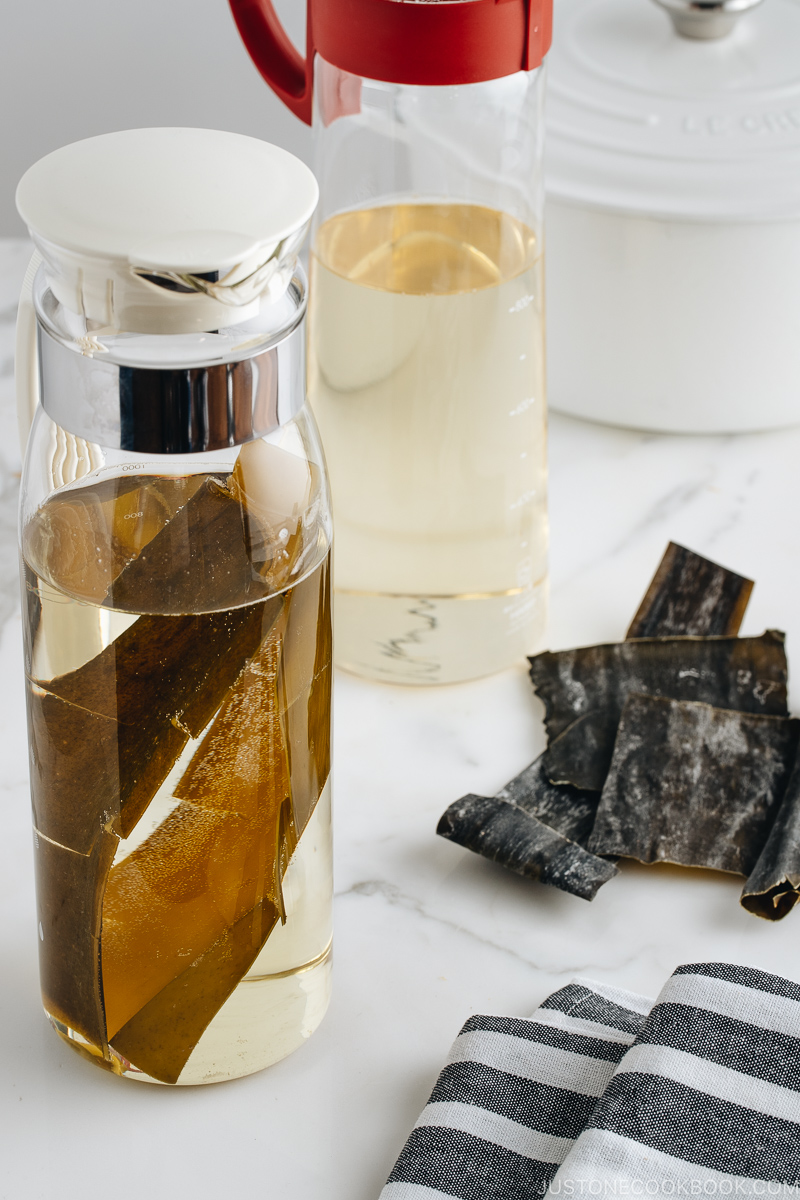
Dashi (Japanese soup stock) is a Japanese soup stock, and it is a fundamental ingredient in many Japanese dishes to create authentic flavor. Today I want to share how to make Kombu Dashi (昆布だし).
What is Kombu Dashi?
Kombu Dashi (昆布だし) is a Japanese soup stock made with kombu (昆布 dried kelp), dried kelp that is used extensively in Japanese, Korean, and Chinese cooking. In Korean, it is referred to as dasima (다시마), and in Chinese as haidai (海带).
Kombu Dashi is vegetarian and vegan and the easiest dashi you can make.
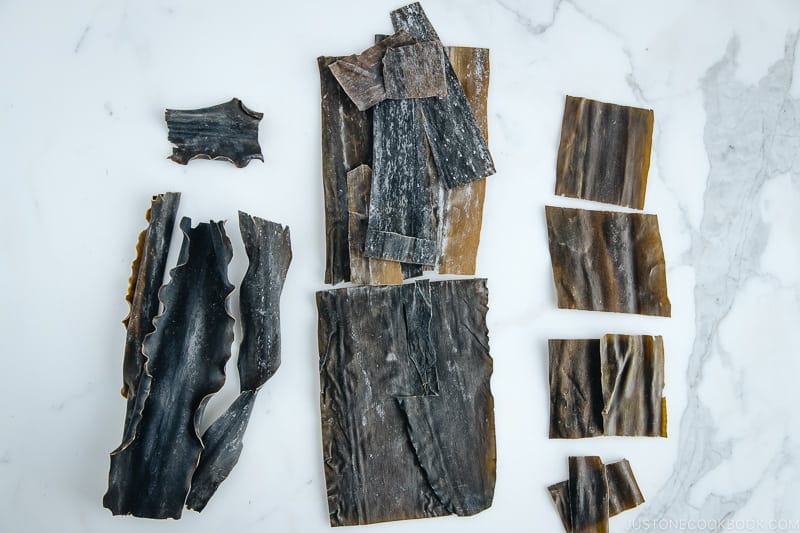
This sea vegetable earns its name as ‘the king of seaweeds’ because it possesses an amazing flavor and nutritional value, unlike any other seaweed. The most noteworthy advantage is its high content of glutamic acid, an amino acid responsible for umami. And umami is what you’re looking for in a dish where it provides a complex, elemental taste.
If you follow a vegetarian/vegan diet or simply want to embrace a more plant-based diet, kombu is an outstanding ingredient to incorporate into your cooking. Besides being a great flavor enhancer and tenderizer, kombu is a powerful, health-promoting food that can make up for certain nutrients that are absent in the diets.
In my pantry kombu page, I discuss different types of kombu and which kombu is good for specific types of food. Please go over the post if you want to know more about how to use kombu for Japanese cooking.
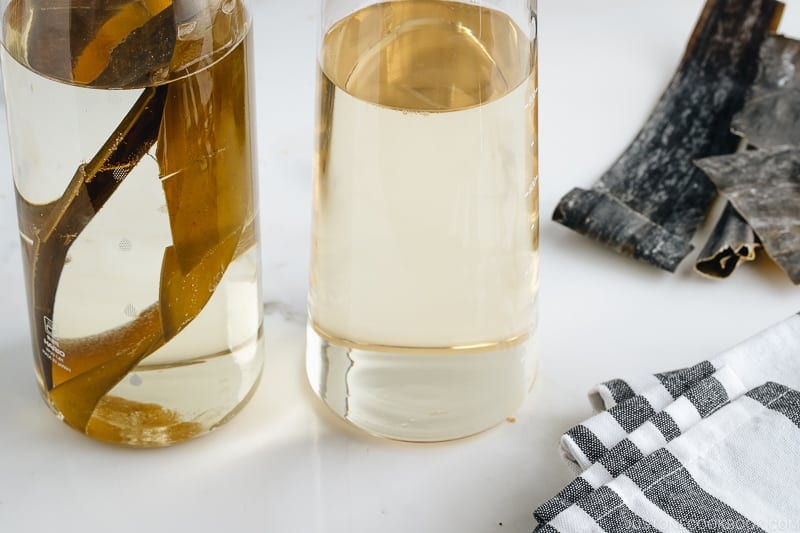
Two Methods in Making Kombu Dashi:
Method 1: Cold Brew
The cold brew or Mizudashi (水出し) method is pretty hands-off. All you need is to put water and 1-2 kombu strips in a large bottle, let steep for 2-3 hours or more.
Method 2: Hot Brew
If you need dashi right away, the hot brew or Nidashi (煮出し) is the method you can go with. Just place the kombu and water in a medium pot and gently bring out the flavor. Turn off the heat before it comes to a boiling point.
A few quick tips on cooking with kombu:
- There is no need to wash or wipe off the white powdery substance as kombu is pretty clean these days. The white compound is known as Mannitol which is the key contributor to the umami.
- Make a couple of slits on the kombu will help release more flavor.
- Do not throw away the leftover kombu as it is can be repurposed into Kombu Tsukudani (Simmered Kombu) or Homemade Furikake (rice seasoning).
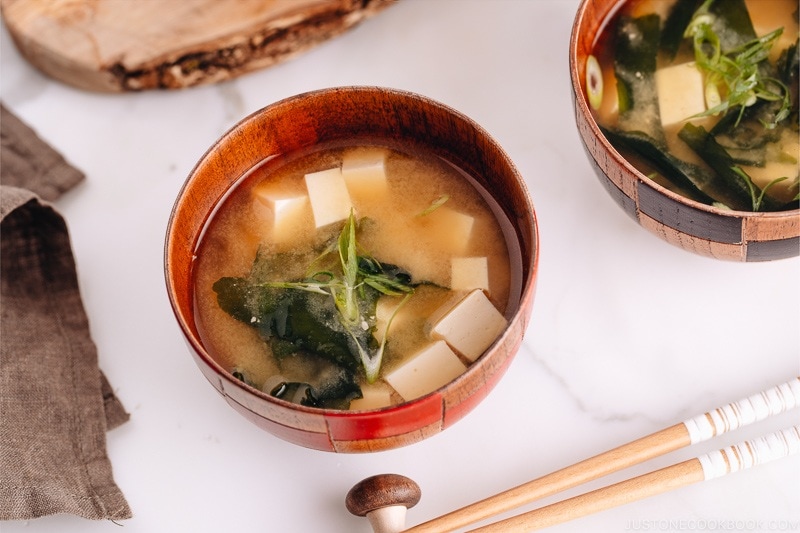
Recipes Using Kombu Dashi
If you can’t access kombu, another delicious option for making another vegetarian/vegan dashi is Shiitake Dashi.
The Ultimate Dashi Guide
Dashi plays an important role as a flavor enhancer in Japanese cooking, so you don’t need to season the food with too much salt, fat, and sugar. Rich in minerals and other vitamins, dashi is considered a healthy ingredient in our daily diet.
There are six different types of dashi you can use in Japanese cooking, including vegetarian and vegan dashi (*).
- Awase Dashi – a stock made from a combination of dried kelp + bonito flakes
- Kombu Dashi * – a stock made from dried kelp
- Katsuo Dashi – a stock made from dried bonito flakes
- Iriko Dashi – a stock made from dried anchovies/sardines
- Shiitake Dashi * – a stock made from dried shiitake mushrooms
- Vegan Dashi * – a stock made from dried shiitake mushrooms and kombu
If you are new to different types of dashi, check out my Ultimate Dashi Guide.
Wish to learn more about Japanese cooking? Sign up for our free newsletter to receive cooking tips & recipe updates! And stay in touch with me on Facebook, Pinterest, YouTube, and Instagram.
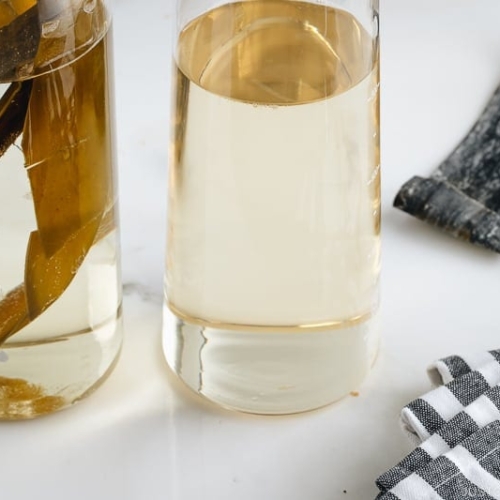
Kombu Dashi (Vegan Dashi)
Video
Ingredients
- 1 piece kombu (dried kelp) (10 g; 4 x 4 inches, 10 x 10 cm per piece)
- 4 cups water
Instructions
- Gather all the ingredients. Most Japanese recipes say to gently clean the kombu with a damp cloth. However, these days, kombu is pretty clean so just make sure it doesn‘t have any mold spots and it‘s ready to use. Do not wash or wipe off the white powdery substance as it has lots of umami.

- Make a couple of slits on 1 piece kombu (dried kelp) to release more flavor.

Method 1: Cold Brew Kombu Dashi (Mizudashi)
- Put 4 cups water and the kombu in a large bottle.

- Put the cap on and let it steep on the counter for 2–3 hours in the summertime and 4–5 hours in the wintertime. You can also cold brew the Kombu Dashi overnight in the refrigerator.

- Remove the kombu from the bottle and reserve the spent kombu (see below). The Kombu Dashi is now ready to use. If you are not using the dashi right away, save it in a bottle and keep in the refrigerator for 4–5 days or in the freezer for 2 weeks. I recommend using it sooner for the best flavor.

Method 2: Kombu Dashi on the Stovetop (Nidashi)
- Put the kombu and water in a medium pot. If you have time, soak for 3 hours or up to a half day. The kombu’s flavor comes out naturally from soaking in water.

- Turn on the heat to medium low and slowly bring to a bare simmer, about 10 minutes.

- Meanwhile, clean the dashi by skimming the foam from the surface with a fine-mesh skimmer.

- Just before the dashi starts boiling, remove the kombu from the pot (see below for what to do with it). If you leave the kombu in the pot, the dashi will become slimy and bitter.

- Now the Kombu Dashi is ready to use.

To Store
- If you are not using the dashi right away, keep it in a bottle or airtight container and store in the refrigerator for 4–5 days or in the freezer for 2 weeks. I recommend using it sooner for the best flavor.
What to do with the spent kombu?
- Save the spent kombu in an airtight container and store it in the refrigerator for a week or in the freezer for up to a month.

- With the spent kombu, you can make Simmered Kombu (Kombu Tsukudani).

- You can also make Homemade Furikake (Rice Seasoning).

Nutrition
Editor’s Note: This post was originally published in February 2013. The images have been updated in April 2019.
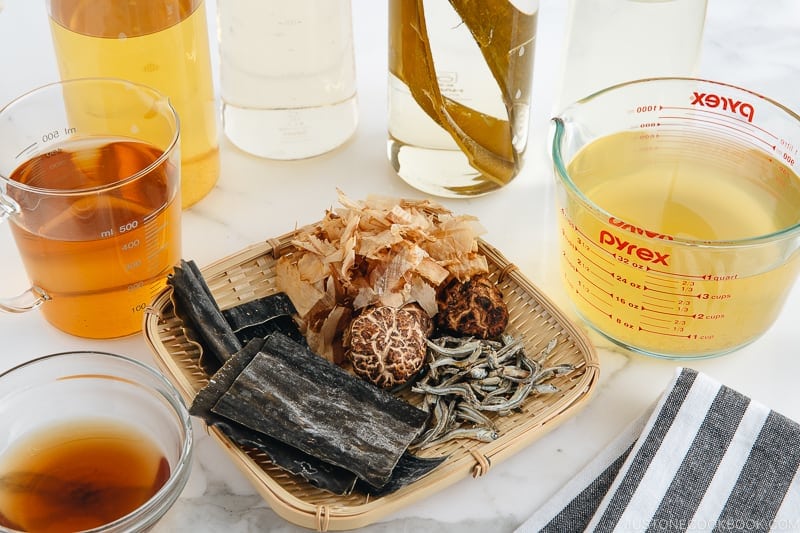
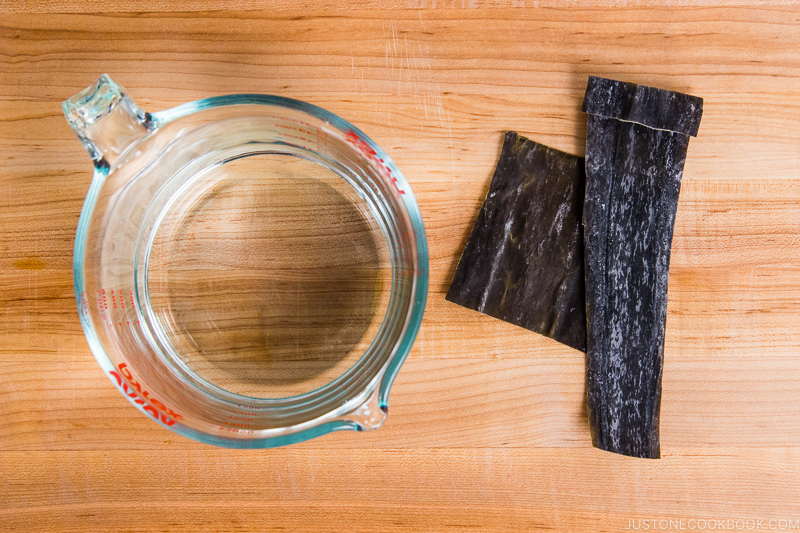
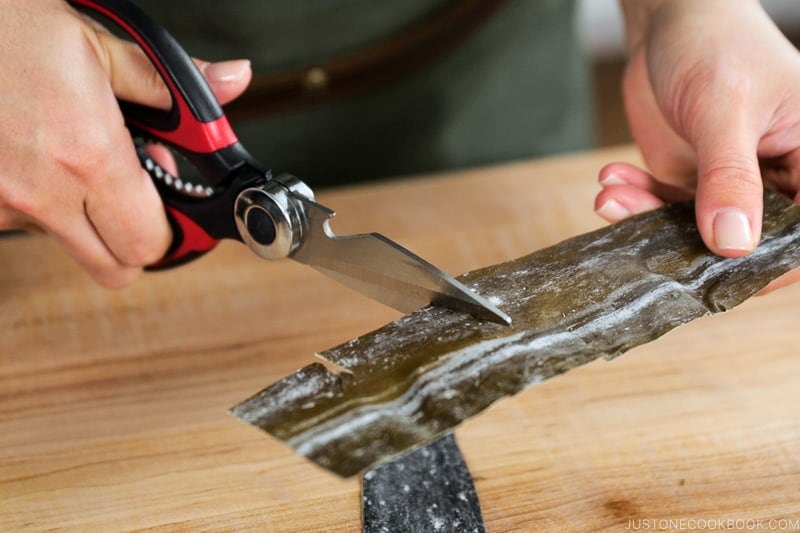
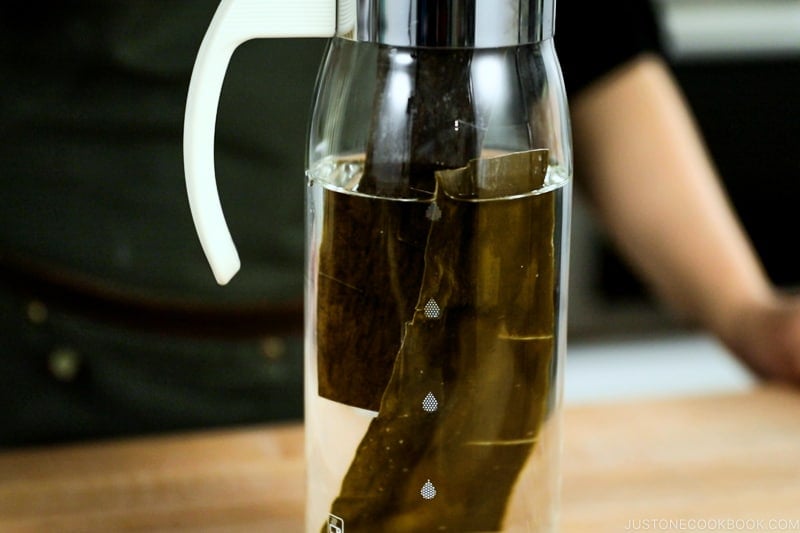
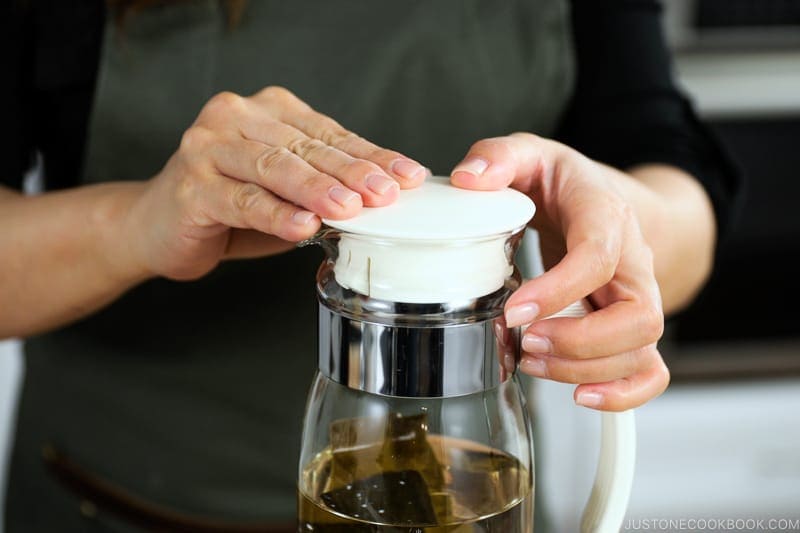
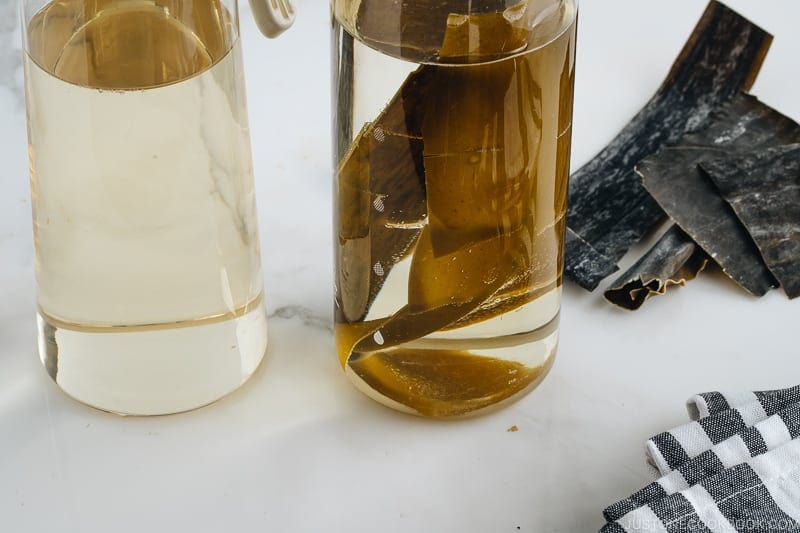
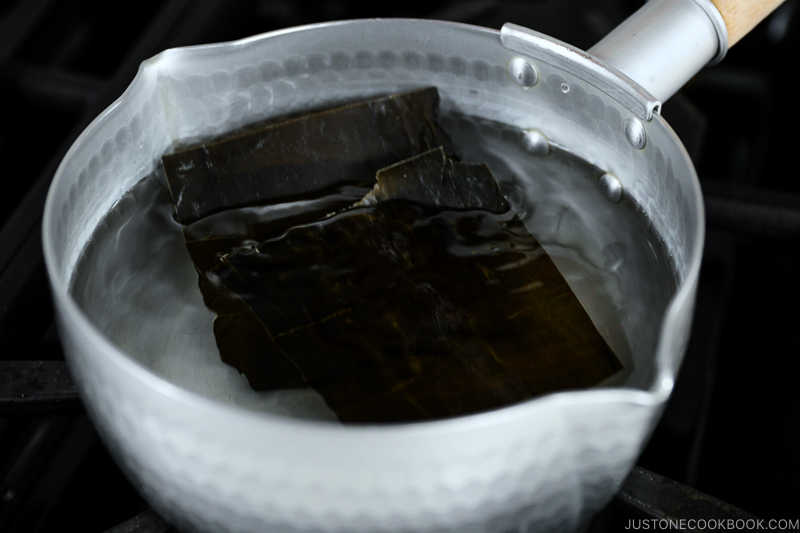
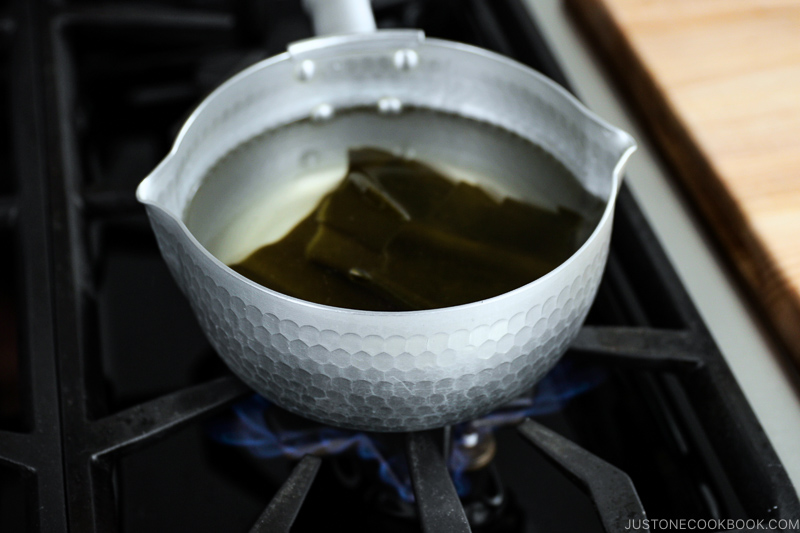
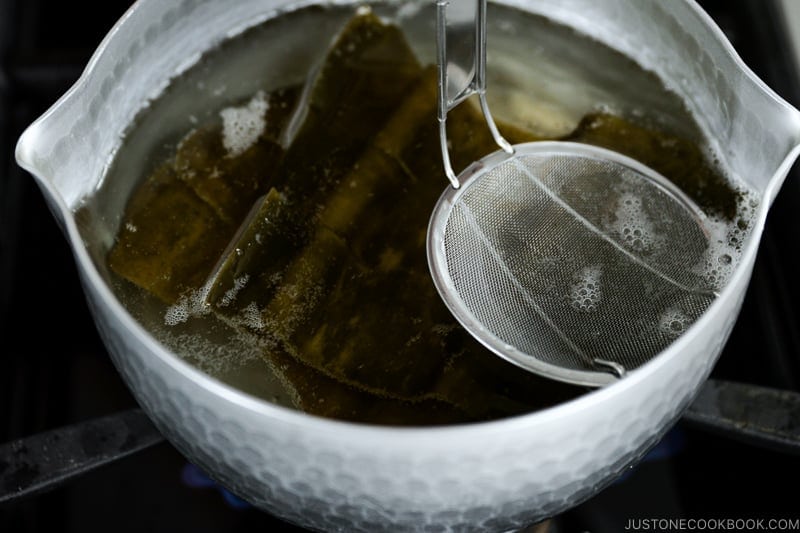
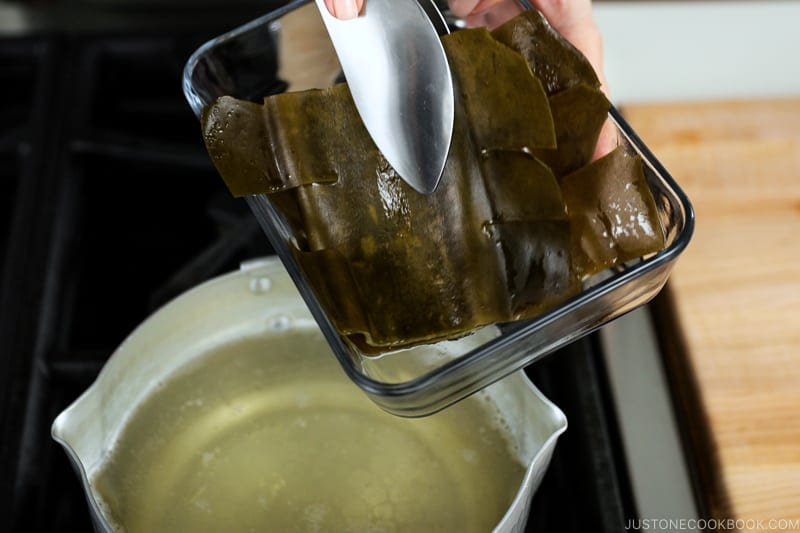
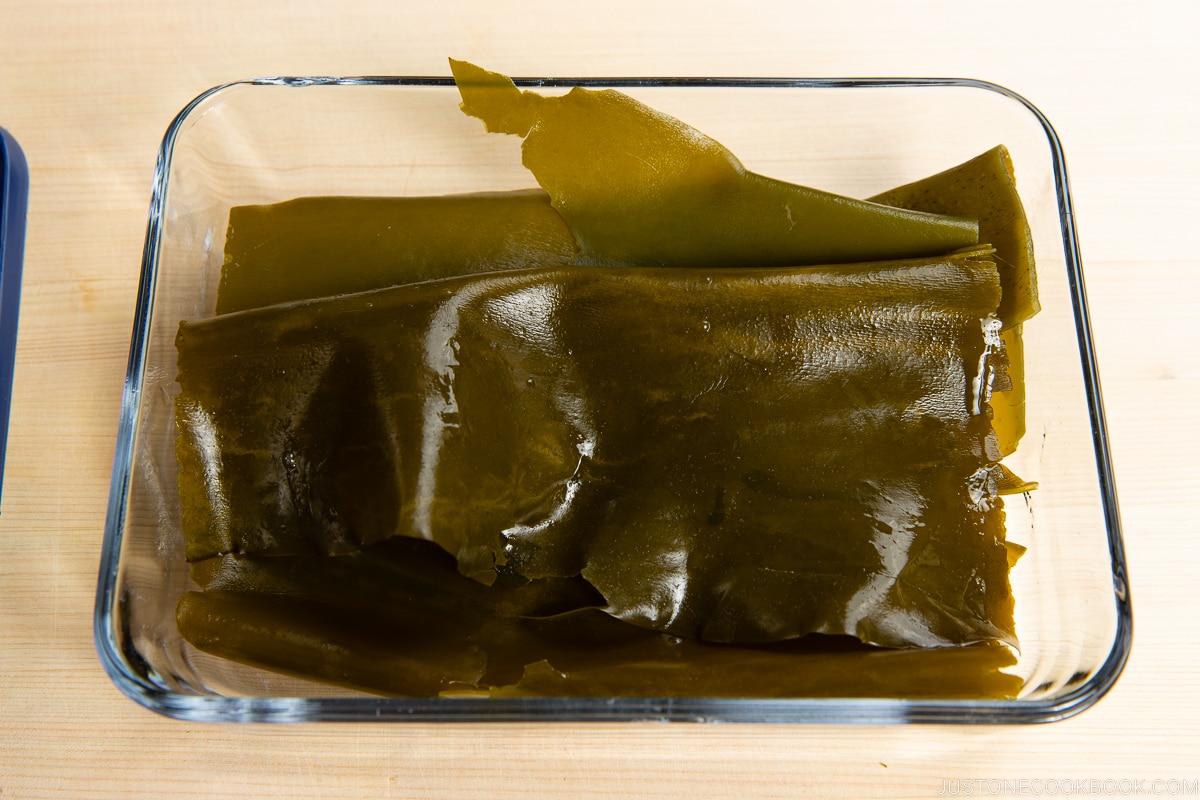
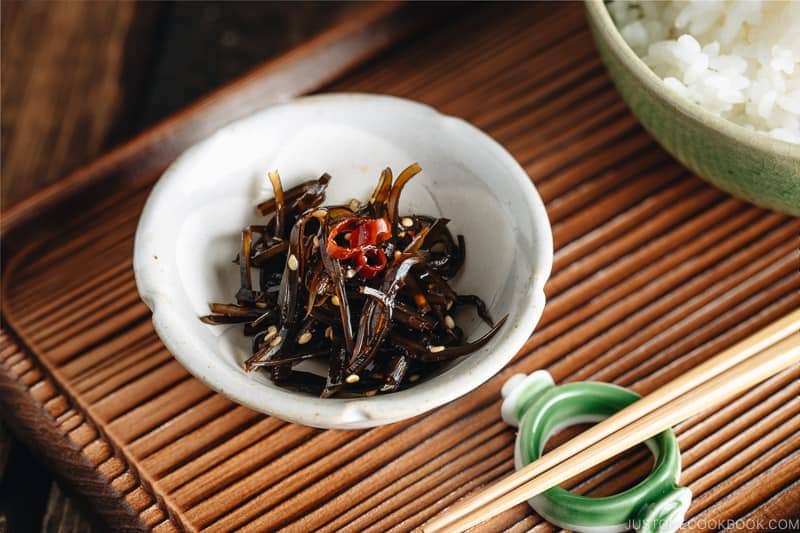
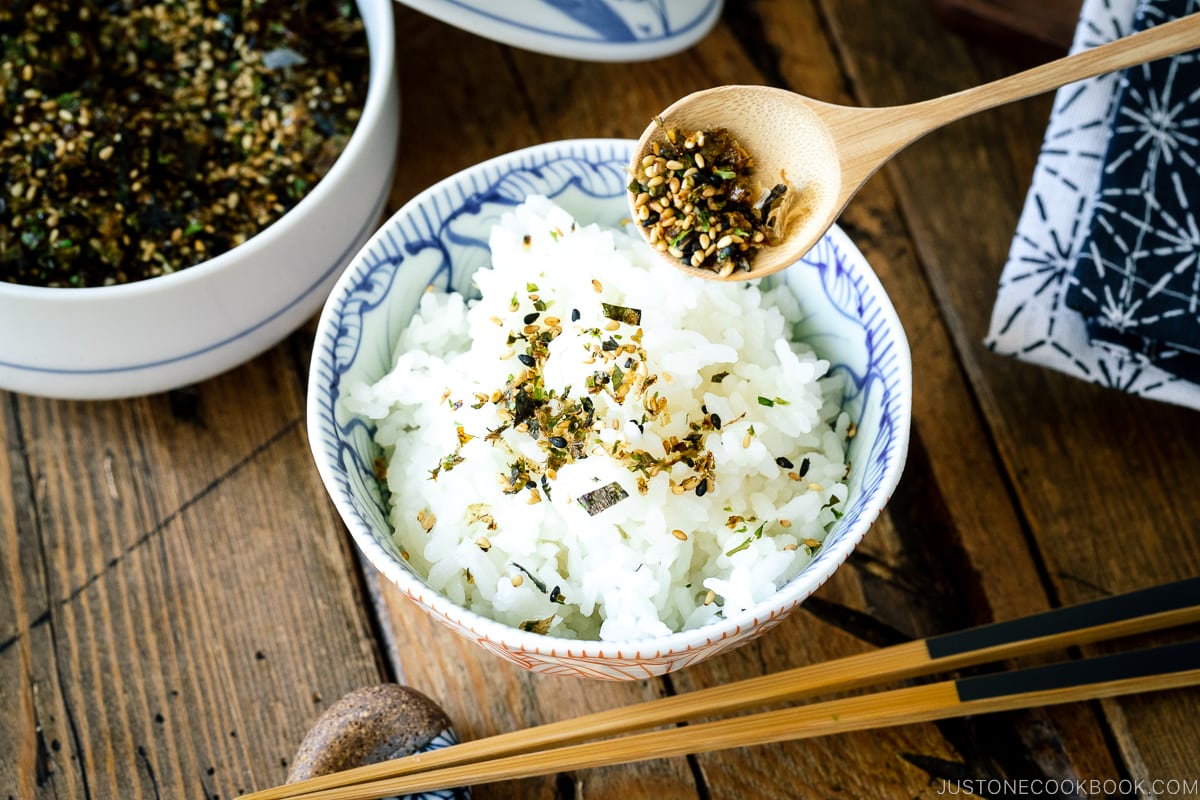










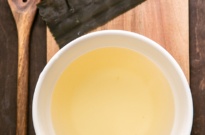
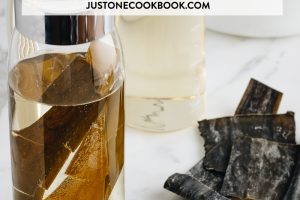
Hey there. Are these Dashi safe for baby? I’m interested in making these Dashi as part of my now 6 months old daughter. Thank you!
Hi Kei, Thank you so much for reading Nami’s post and trying her recipe.
Yes. In Japan, we start at 6 months of age. However, we recommend starting with a teaspoon to evaluate whether a baby has an allergy response.
If you’re interested, there’s a post on Japanese baby food here.
https://www.justonecookbook.com/baby-food-in-japan/
Happy Cooking!😊
This is amazing for people like me who are not vegetarian but allergic to seafood. Traditional fashion will kill me so I have had to stay away from many traditional Japanese dishes but now I can try them!
Hi Aleks! Thank you so much for reading Nami’s post and for your kind feedback!
We are glad to hear you enjoyed a different way of making Dashi.
You might also want to look into Shiitake Dashi: https://www.justonecookbook.com/shiitake-dashi/
We hope you enjoy it! 🤗
As me being Korean, I found many similarity in Japanese and Korean cooking. Thank you for sharing the information and I really enjoy your blog!!
Hi Anne! Thank you very much for reading Nami’s post and for your kind feedback!
We are so happy to hear you enjoyed our website and everything else that we share. It means so much to us.
Happy Cooking!🥰
Where can I get the beautiful bottles that hold the Dashi in your Dashi article?
Hi Larry! Thank you very much for reading Nami’s post!
The bottles are from Hario. You can find the link here: https://www.amazon.com/shop/justonecookbook/list/JD39FUPH6SRN
We hope this helps!
Hello Nami!
I just had a question, is it possible to oversteep or brew the cold variation? I went to leave mine in the fridge but forgot it for a couple of nights wondering if that’s ok or if it’ll taste too bitter or something? Thanks for the help, your recipes are fantastic.
Hi, bry! Thank you very much for trying Nami’s recipe and for your kind feedback!
If you leave the Kombu too long in the water, the Kombu dashi becomes slimy, cloudy, and smell like seaweed. If that is the case, you may want to retry making Kombu Dashi.
We hope at next try you make sure to take it out Kombu. 😉
hello,
i tried the to make kombu dashi by boiling once i got hold of one, but need some pointer.
Once the water is about to boil, i took out the kombu, but find it quite hard and the dashi is quite bland in taste. Should i boil the kombu longer or issue with kombu itself? This affect the furikake too as it is too hard to chew.
Hi Kevin! Thank you very much for trying Nami’s recipe!
It depends on the type of Kombu, some of them would take a little longer to get soft. We recommend soaking the Kombu a little longer (up to a half-day).
Kombu’s flavor and Umami come out naturally soaking in water than boiling them longer.😉
We hope this helps!
Hi Nami
Can I wrap the Kombu in Aluminium foil, put in airtight container, freeze it to improve the shelf life?
Any other ways to store it?
Hi Cyndi, Thank you very much for reading Nami’s post!
Sure, you can store them in the freezer. But we believe Aluminium foil is unnecessary.
https://www.justonecookbook.com/kombu/
We hope this helps!
Hi Nami,
Thank you for your great blog! I just have one concern about iodine extracting from kombu as I ve read it might reach a very dangerous high level. I didn’t find trustable info googling so my last option is asking here 🙂 Do you know how iodine extraction can be regulated for dashi? I’ve read 2-3h of soaking extracts ±90% of iodine from kombu and this exceeds daily intake by far
Hi Alex! Thank you very much for reading Nami’s post!
Unfortunately, We do not have a lot of information to share, but we can recommend using another type of Dashi or reducing the soaking time as needed.
https://www.justonecookbook.com/how-to-make-dashi-jiru/
We hope this is helpful.
Hi Alex,
the average iodine consumption of Japanese people exceeds western intakes by about 10 fold. Importing a foreign diet has it’s risk. If 2-3h soaking removes 90% of the iodine you should be fine by discarding that water and use fresh water as primary kombu dashi is usually made by soaking over 6-8h followed by shortly simmering (NOT BOILING it will turn bidder!) and then removing the Kombu. Secondary Kombu dashi can be made using that Kombu, by simmering it for 30 minutes. I reccomend to use two pots for this, a large one filled with water and a smaller which you use for the ingrediants. Put the smaller pot in the larger one then it will never surpass 100°C when cooking. Secondary Kombu dashi is weaker in flavour but contains much less iodine if what you read was correct. 😀 hope that helped. My Kombu package states on it’s backside that daily consumption of more than 5 g of the stock can lead to hyperthyroidism.
Hi so if a recipe calls for say 2 teaspoons of kombu dashi powder can I substitute with this homemade dashi stock? How much stock would I use to equal 2 teaspoons? Thank you
Hi Noam, Thank you very much for reading Nami’s post!
May I know which recipe you are referring to from our site? It depends on the recipe, you can replace it with homemade Dashi, but some recipes don’t want the liquid form.
It was not a recipe from this site. It was a recipe in a cookbook for Tofu and Seaweed Miso Soup. It says to boil 3 cups of water with 2 teaspoons of dashi powder and then add wakame and tofu, and then miso.
Hi Noam, I see. To make miso soup, You can make your favorite homemade Dashi and replace the 3 cups for the recipe.
We hope this helps!🙂
This may seem silly, but how do you use frozen kombu for tsukudani? Do you just thaw it overnight in the fridge?
Hi Ahri! Thank you for trying Nami’s recipe!
If it’s cooked frozen Kombu, yes, you can thaw overnight in the fridge or until it gets soft enough to cut.
We hope this helps!
Nami
I don’t live without dashi or even less with nori, shoyo and finally everything. Dashi brings light aromas and a lot of smoothness in all the dishes I use. Excellent choice to start with dashi. I missed talking to you about your dishes. Take care and have a good appetite!
Syd.
Hi Syd! I think once you get used to the flavor of Japanese dishes, it’s hard to imagine the dish without dashi. It’s subtle yet really the core of the Japanese flavors. Happy cooking!
Hi Nami! Love your recipes, but I tried the cold brew method with mommy and it got slimy after 2 hours on my counter. Its not hot where I live, mild climate year round. Is it ok to use or should I try again?
Hi Dee, Thank you very much for trying Nami’s recipe!
It depends on the type of Kombu and water; the Kombu would get slimy quicker sometimes.
If just the Kombu is slimy, it’s normal and ready to use, but if the Dashi itself is slimy, you may want to try it again for better taste. However, some people prefer the slimy texture and taste of the Dashi, which is ok to use.
We hope this helps!
Hi Nami! Thank you for all the wonderful information.
Following on your answer to Charlotte’s question about cold soaking kombu (and in my case adding shiitake), if I have something like a week to cold soak, is soaking longer still better? Is there a maximum time to cold soak, or is this something that within reason more is always better?
Hi Anthony, The maximum time for the cold brew is 12 hours.
The Kombu will start to release too much Alginic acid in the Dashi after 12 hours and result in slimy Dashi.
We hope this helps!
Was a little hesitant making my own dashi then I found your website (which I’m borderline obsessed with btw). Thanks for this great recipe and tips!
Hi Kate, We are glad to hear you enjoy Nami’s many recipes and tips!
Thank you very much for trying recipes and for your kind feedback.☺️
I enjoyed watching and learning about dashi, but I still have to find some of the ingredients which is not available where i live. I would want to learn more about Japanese cuisine. Thank you very much.
Hi Dennis! You are in the right spot!
We encourage you to follow this link. https://www.justonecookbook.com/start-here/.
We hope this is helpful!☺️